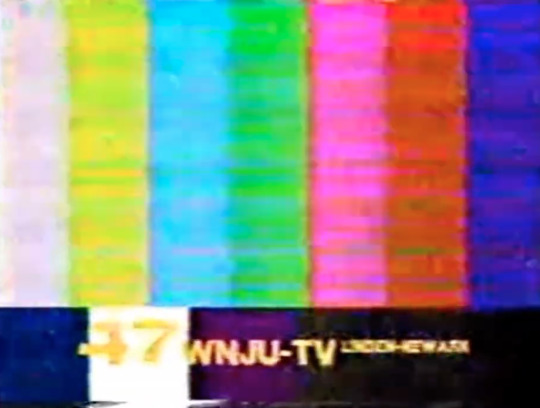#WNJU
Photo

Como siempre tratamos de tener productos novedosos en nuestras filas y ya contamos con estos vehículos de colección escala 1/64. En esta ocasión es un taxi Checker de la película de "John Wick". Ya puede ser tuyo a un super precio, de $700 queda en $350 #distribuidoraejeo #greemlight #vehiculo #carro #auto #carros #autos #autoclásico #clásicos #clásico #cars🚘 #car #cars #escala #modelismo #johnwick #1974taxichecker #1974 #checker #taxi https://www.instagram.com/p/ChR-wNju-iE/?igshid=NGJjMDIxMWI=
#distribuidoraejeo#greemlight#vehiculo#carro#auto#carros#autos#autoclásico#clásicos#clásico#cars🚘#car#cars#escala#modelismo#johnwick#1974taxichecker#1974#checker#taxi
1 note
·
View note
Text
0 notes
Text

Teenage Homunculi A-Go-Go
#zacherley#john zacherle#disc-o-teen#wnju-tv#channel 47#newark#new jersey#1965#horror host#teenagers
110 notes
·
View notes
Audio
Sonny Terry, Brownie McGhee, and Pete Seeger perform "Key to the Highway" on episode 34 of Rainbow Quest
Rainbow Quest was a television program produced for one series run in 1965 and 1966 by the Advertisers Broadcasting Company for UHF station WNJU-TV in the New York City market. Throughout the show's 39-episode run, writer and curator of American folk songs Pete Seeger hosted many guest musicians
20 notes
·
View notes
Video
youtube
Sonny Terry and Brownie McGhee Key to the Highway, Live on Pete Seeger’s “Rainbow Quest” Television Show 1966
At the time of this show, Pete Seeger was still blacklisted from appearance on regular network TV, as he had been since the 1950s. However, these programs were recorded on a teeny, tiny New York City local station ( WNJU-TV) and were seen by very few people, as most people’s TVs were incapable of picking up the uncommon UHF signal. Seeger did not appear on regular broadcast TV until 1967, when Tommy and Dickie Smothers essentially forced their network, CBS, to book Seeger onto their “Smothers Brothers Comedy Hour” program. The network did allow him to perform, but erased Seeger’s performance of the anti-war song “Waist Deep in the Big Muddy” from the tape before broadcast. This really made Tommy Smothers angry. The brothers booked Seeger for their show again a few months later, and leaked to the press a list of political songs Seeger was to sing on the show. Needless to say, the advance word prevented CBS from censoring Seeger.
And why I’m relating this story on a video by Sonny Terry and Brownie McGhee, I have no idea. I guess that’s just the way my little brain works...
48 notes
·
View notes
Text
#LMSP2017 Fellow Takeover: Véronica Méndez
¡Hola gente! Thank you for taking the time to check out my #LMSP2017 #fellowtakeover blog post where I will share my experiences as a Latino Museum Studies Program Fellow at the National Museum of American History (NMAH).
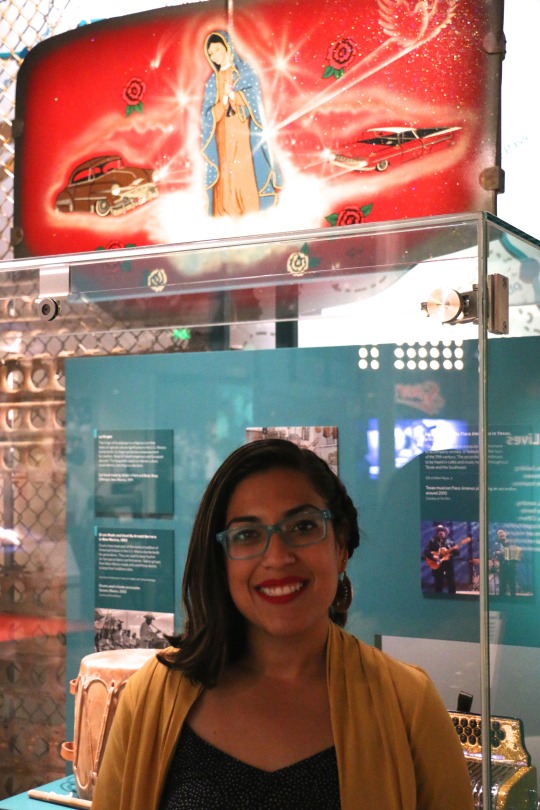
Véronica Méndez standing in the Many Voices, One Nation exhibit in the National Museum of American History. (Photo by Rudy Mondragón)
I’d like to start by introducing myself. My name is Véronica A. Méndez and I am a Ph.D. candidate and mama scholar in the Department of History at the University of Illinois at Urbana-Champaign. I was born in México and grew up in San Antonio, Texas (Go Spurs Go!). My doctoral research lies at the intersection of Borderlands Studies, Chicana/o Studies, Latin American and U.S. History. Broadly, my dissertation interrogates how Tejanas, (women of Spanish-Mexican origin) experienced and influenced the course of empire and nation-state formation during the nineteenth century in San Antonio, Texas, across Spanish, Mexican, and Anglo-Texan rule.

Dr. Mireya Loza, project lead of Documenting Spanish-Language Television, and Véronica Méndez, 2017 LMSP fellow. (Photo by Carlos Parra)
Under the direction of Dr. Mireya Loza, and in collaboration with Dr. Katherine Franz, from the Division of Work and Industry at the National Museum of American History, I am working on a project titled ¡Escuchame!: the History of Spanish Language Broadcasting in the U.S. My primary role is processing oral histories related to the development and rise of Spanish language television. The oral histories collected document the experiences of producers, reporters, chief engineers, writers, camerawomen, anchors, and set designers across six Spanish television networks: KMEX (Los Angles), KVEA (Los Angeles), SIN, WKAQ (San Juan), WNJU (New Jersey and New York), and WSCV (Miami). Together, these oral histories provide an in-depth historical perspective as new broadcasting technologies offer new and far-reaching avenues for the Latina/o communities to represent themselves and claim space within the larger fabric of the nation.
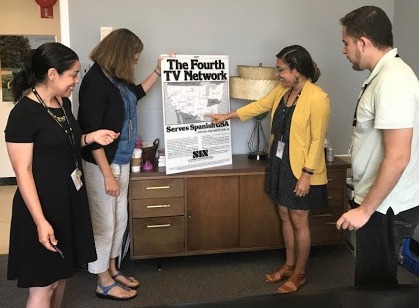
Weekly meeting at the NMAH. From left to right: Dr. Mireya Loza, Dr. Kathleen Franz, 2017 LMSP fellows Véronica Méndez and Carlos Parra. (Photo by Hannah Gutiérrez)
Currently, my research focuses on the life and career of Gilda Miros, a Puerto Rican born, Nuyorican identified, author, theater and screen actress and television and radio broadcaster. Miros immigrated from Santurce, Puerto Rico to the Bronx in New York City as a small child; she later relocated to Mexico City to pursue an acting career and eventually becoming a radio and television broadcaster for SIN, WAPA, WXTV, Telemundo, WADO, JIT, and SBS. Miros’s oral history helps us understand issues of representation in media and television, along the lines of race, gender, and class, ethnicity, and nation, as well as the transnational networks that informed the development of Spanish-language broadcasting.

Handling Gilda Miros material at the National Museum of American History. These particular items document Miros travels to Vietnam as a presenter with the USO during the Vietnam War. A Puerto Rican serviceman gifted the green army hat to Miros. (Photo by Carlos Parra)
In addition to processing oral histories, I have received training in best practices for handling and processing objects acquired for the collection. These items will be utilized for an upcoming exhibit. The Smithsonian Archive Center at the National Museum of American History also houses the Spanish Language Broadcasting Collection, 1963-2015. This collection includes photographs, film stills, design plans, ratings statistics, programming, advertising, and programming for WNJU, WKAQ as well as material documenting Gilda Miros work as an actress, model, radio announcer and television talk show. Together, these objects capture significant moments in history and help frame the narrative on Spanish Language Television.

Jenarae Alaniz, Museum Specialist in the Division of Work and Industry, and Véronica Méndez looking through recently processed ¡Escuchame! objects at the National Museum of American History. (Photo by Rudy Mondragón)

Handling a large collection press badges belonging to Cuban-American journalist José Díaz-Balart. (Photo by Rudy Mondragón)
I am excited to be a 2017 Latino Museum Studies Program fellow and contribute to the ¡Escuchame! project. The history of Spanish-language media serves as a rich archive for documenting the hopes and anxieties of a growing Latina/o community, across time, as well as underscoring the rich diversity that defines it.
Follow the #LMSP Fellows via Instagram @smithsonian_lmsp @slc_latino, the Smithsonian Latino Center Facebook page or via Twitter @SLC_Latino.
6 notes
·
View notes
Photo
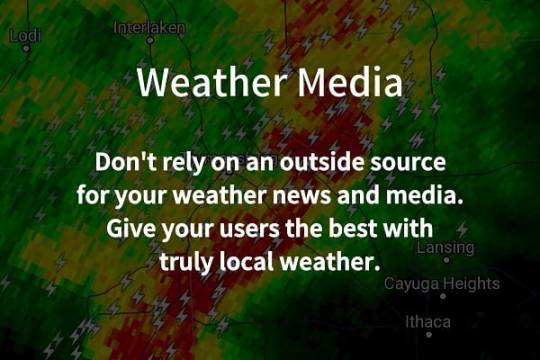
***ATTENTION ALL NYC NEWS CHANNELS *** . . . . Adopt this and make it canon. All the technology in the world and you can't even come close to a near accurate and acceptable prediction. Salt on the streets. Buses with chains on. Extremely exaggerated warnings and not a millimeter of snow seen. . . . . Channel 2: WCBS-TV - (CBS) - New York City, CBS 2Channel 4: WNBC - (NBC) - New York City, NBC 4 New YorkChannel 5: WNYW - (FOX) - New York City, FOX 5, WABD when it was the Flagship station of the DuMont Television Network, became WNEW before 1986Channel 6: WNYZ-LP - KRB NY Radio Korea, Low power TV station operation primarily as a radio stationChannel 7: WABC-TV - (ABC) - New York City, ABC 7 or Channel 7Channel 9: WWOR-TV - (MyNetworkTV) - Secaucus, NJ, My 9 (New York City), known as WOR before 1987Channel 11: WPIX - (CW) - New York City, PIX 11 (formerly WB 11)Channel 13: WNET - (PBS) - Newark, New Jersey/New York City, ThirteenChannel 17: WNDT-CD - (MHz Worldview) - New York CityChannel 21: WLIW - (PBS) - Garden CityChannel 25: WNYE-TV - (Independent) - New York City, NYCTV LifeChannel 31: WPXN-TV - (ION) - New York CityChannel 33: WJLP - Me-TV - New York City/New Jersey WJLP New Jersey/New York Call letters changed mid-night 10/1/2014 from KVNV to WJLP. On March 16, 2015 the FCC ordered WJLP to move their broadcasts from channel 3.10 to channel 33.1 on an interim basis.[1]Channel 41: WXTV - (Univision) - Paterson Univision 41 Nueva YorkChannel 46: WMBQ-CD - (MHz Worldview) - New York City, Simulcasting on WNDT-CDChannel 47: WNJU - (Telemundo) - Linden, Telemundo NY https://www.instagram.com/p/Bs2y5WlBTTb/?utm_source=ig_tumblr_share&igshid=s35ffuzde6ih
0 notes
Text
NBC Telemundo License LLC Satellite Earth Station SES-REG-20180919-04406
NBC Telemundo License LLC has filed for satellite earth station via FCC International Bereau licensing filing. C-band receive only earth station to provide video, audio and data services from satellite for TV station WNJU
from International Bureau Filings FCC.report https://ift.tt/2CHXvfp
from Tumblr https://ift.tt/2Kp62rU
from Blogger https://ift.tt/3544Br0
from Tumblr https://ift.tt/2rH0Vgd
from Blogger https://ift.tt/2qXQqER
0 notes
Text
NYC OTA Viewers Need to Rescan for New Channels
With the channel repack entering its final year, Durst Broadcasting — which manages the broadcast antenna facility atop One World Trade Center — announced this week that it had successfully completed Phase 4 of the repack. The organization urged New York City residents to rescan their TV sets in order to receive the channels in their new spots on the spectrum band.
The channel repack is a result of the 2017 FCC spectrum auctions, which requires nearly 1,000 U.S. television broadcasters to move to new channels to make way for new wireless companies to occupy former broadcast spectrum. For New York, where most of the TV stations host their antennas on top of One World Trade Center, Durst has been planning and coordinating the transfer for years, according to John Lyons, assistant vice president and director of broadcast communications for The Durst Organization.
“We have been working with the broadcasters and equipment suppliers for well over a year to make this transition a smooth one,” Lyons said. “Thanks to the efforts of the New York City broadcast community, equipment supplier RFS Myat and systems integrator DSI RF Systems Inc., we were ready for this operation on Aug. 1 as scheduled. Within a few minutes, the stations were on their new channels.”
The stations involved include:
WCBS
WLIW
WNBC
WNJU
WNYW
WWOR
WRNN
WPXN
Planning for the repack began before the World Trade Center Broadcast site became operational in mid-2017 and involved the installation of a redundant combiner and antenna systems that allowed all the stations to continue operations while Durst updated existing hardware.
Consumers who watch television over the air will need to rescan their TV sets in order to receive the new channels. Subscribers to satellite or cable TV do not need to rescan. Viewers should also rotate their antennas toward One World Trade Center for the best reception.
For more news and insight on the repack, visit TV Technology’s repack silo.
[Subscribe to our newsletter and get it delivered right to your inbox.]
The post NYC OTA Viewers Need to Rescan for New Channels appeared first on Radio World.
from rssminimix https://ift.tt/2KlNlVj
via IFTTT
from dxerhamnews https://ift.tt/2yw3kL4
via IFTTT
0 notes
Text
0 notes
Text
If you want to do something well, watch someone else do it. That’s the way to improve in most skills in life.
That’s one reason I read Scott Jones’ blog, FTVLive.com. Say what you want about him or his spelling, but he’s usually right on the money when it comes to facts, and won’t make claims without backing them up. In other words, I trust what he writes.
This morning, he had two blog posts about the latest attempt to create the nation’s largest local television station owner: Nexstar Media Group’s effort to buy Tribune Media. (Last year, after a lot of opposition, Sinclair Broadcast Group was not allowed to make the purchase.)
When you get this big, things get complicated. The company gets up against against Federal Communications Commission ownership limits, as well as Department of Justice antitrust regulations.
Nexstar owns or operates 174 television stations in 100 mostly small to mid-sized TV markets, reaching nearly 38.7 percent of American households. The limit is 39 percent, and that’s with the FCC’s UHF discount, which only takes half the market’s people into account. Tribune owns or operates 42 stations, including the nation’s biggest cities.
The deal is that Nexstar will pay $4.1 billion for Tribune. Sinclair had offered $3.9 billion but according to USA Today, “breached its contract by misleading regulators during the transaction’s approval process.” Nexstar’s last major purchase was in 2017, when it bought 71 stations from Media General for $4.6 billion.
The ownership limits, which I explained in this post from last March, come into play because two large companies will already own stations in the same markets competing against each other, and will together own too many as a whole. That’s why some stations will need to be sold.
Briefly, the four categories of FCC rules are 1. national TV ownership, 2. local TV multiple ownership, 3. the number of independently owned “media voices” – 4. and at least one of the stations is not ranked among the top four stations in the DMA (that’s the “designated market area” or city, and ranking based on audience share), and at least eight independently owned TV stations would remain in the market after the proposed combination. (Keep in mind, these rules seem to get loosened every time a company comes close to hitting the limit.)
In the case of Nexstar and Tribune, there would be a long list involving about 15 cities. (Nexstar would do well by being honest in its effort to buy Tribune, as opposed to what Sinclair did and had been doing for years.)
Perry Sook, Nexstar’s president and CEO, started the company in 1996 with one station in Scranton, Pa. He has been buying ever since.
“We have no aspirations to be a national anything,” Sook said, according to Variety. “Our company goes from Burlington, Vermont to Honolulu and each of those communities have different needs and different tastes. We do three things that are vitally important: We produce local news content. We deliver entertainment and information. And we help local businesses sell stuff. Those are our reasons to exist.”
That’s contrary to Sinclair, which was reportedly interested in creating a national news network and using must-runs on its stations to spread its ownership’s conservative beliefs.
COMING UP: Why Nexstar would spin off WPIX and WSFL, why it wouldn’t want stations in New York and Miami, and what the options are in those important cities.
Anyway, this morning, Scott wrote,
“Sources tell FTVLive that Nexstar is not planning on keeping WPIX in New York City after it purchases the station as part of the Tribune deal.”
So if Nexstar pretty-much owns so many stations in small to mid-sized TV markets, and claims to be solely interested in local broadcasting (while probably taking advantage of some scale), why leave out a station in the #1 TV market in the country, which itself broadcasts to about a whopping six percent of American households?
According to Scott,
“The spinning off of WPIX will help bring Nexstar under the ownership cap and it will likely put a lot of money back into the Nexstar back account.”
I’d rather see competition remain in New York. I can’t imagine Nexstar losing the power of selling ads on stations in every one of the biggest, influential, most lucrative cities (New York, Los Angeles, Chicago, Philadelphia, San Francisco, Washington, etc.). And it could probably make money selling off many of its smaller market stations, have fewer people doing the same jobs on payroll, pay less for benefits like health insurance, have less regulatory paperwork to do, etc. But it could possibly achieve what Scott suggested in just one move.
Instead of Nexstar, I dread a New York competitor coming in and gutting WPIX’s news department, which has grown over the years from 30 minutes at 7:30pm and an hour at 10, to include morning and early evening news.
Among competitors, WCBS already owns WLNY (Long Island). WNBC already owns WNJU (Telenundo). WNYW (Fox) bought WWOR and got rid of its news department. That pretty much leaves WABC, which is said to be in the buying mood since owner Disney hasn’t bought stations in years, is not up against ownership limits, and has been said to be interested in Cox’s stations (especially its ABC affiliates in Atlanta, Orlando and Charlotte). A duopoly in New York would be good for WABC, but not the public, which owns the airwaves. But considering the other major stations already own second stations in the Big Apple, could WABC be refused?
Of course, Disney/ABC is already buying most of 21st Century Fox’s assets, including its TV and movie studios, and cable channels except news and business, for $71 billion. The New York Post reports the closing is expected in February or March, and Sinclair may end up buying Fox’s regional sports networks which Disney can’t keep (it already owns ESPN) and nobody else seems to want them.
The so-called New Fox would consist only of its TV stations, and its news and business cable channels. (Comcast/NBC wanted Fox’s entertainment assets but Disney/ABC offered more. Comcast is ending up with Fox’s share of European telecommunications and pay-TV giant Sky.)
Scott also wrote,
“Along with spinning off WPIX in New York, Nexstar plans on selling off WSFL, the Tribune station in Miami.”
We’ve been through this before. Fox has a great Miami affiliate, WSVN, which is owned by Ed Ansin’s Sunbeam Television Corporation. In the 1980s, he wouldn’t sell to then-affiliate partner NBC, so the peacock bought WTVJ in early 1987 and took away WSVN’s #1 primetime programming on Jan. 1, 1989. WSVN became a Fox affiliate on the few days the new network broadcast back then and put its future into local news, more sensational back then, which has worked out well.
Then, just a few years ago, the same thing happened with Sunbeam’s WHDH in Boston. Ansin refused to sell to NBC so the peacock invented a station pretty much from scratch to put its programming. Since Boston already had a Fox affiliate (Miami’s went to CBS in 1989), WHDH is now completely independent, without a network, and worth much less.
So Fox has been selling off assets but is interested in buying TV stations (with a deal to buy several from Sinclair after its merger with Tribune that fell through) and rights to live programming, especially sports and especially the National Football League. In the past, Fox wanted stations in cities with NFC teams because it broadcasts NFC team away games on Sunday afternoons. Then, it bought the rights to Thursday Night Football, which includes the whole league, so now it’s interested in stations in cities with AFC teams, like the Miami Dolphins.
I’ve shown you how networks have dumped highly-rated, loyal, long-time affiliate stations and went all-out to own stations in cities around the country, even if it meant starting a news department from nothing, which is exactly what WSFL has when it comes to news.
Why would Nexstar sell Tribune’s only Florida station when it doesn’t have much to show for itself in the Sunshine State? Good question! Nexstar only owns WFLA in Tampa, WKRG in Mobile/Pensacola and WMBB in Panama City. Maybe it knows it could get a great deal from Fox (perhaps part of a multi-station deal where Nexstar and Tribune have too many stations competing), or it knows global warming will have Florida under water sooner rather than later.
One thing I disagree on with Scott about Fox possibly buying WSFL is that WSVN would probably not exchange affiliations with that current CW affiliate and become the new one. That’s because CBS is a part owner of The CW and that affiliation would likely go to its second Miami station, WBFS, which would probably mean WSVN ends up with WBFS’ MyNetworkTV affiliation.
On the other hand, Philadelphia MyNetworkTV affiliate WPHL (owned by Tribune) airs off-network syndicated reruns from 8 to 10pm (a great idea!) and its MyNetworkTV obligations (pretty much syndicated dramas) air overnight. It also got rid of the “My” on its logo.
I checked because WBFS-Miami and WWOR-New York air the same shows from 8 to 10 (and Fox owns both WWOR and MyNetworkTV, so the shows will definitely run in pattern).
Anson’s WHDH – which has been independent for two years – airs Family Feud for an hour at 8 and local news from 9 to 11:35pm. So there are alternatives.
What’s going to happen? Are the reports from Scott true? If so, are they subject to change?
Again, we’ll have to sit back on our couches, and wait and see.
Disappointing news and news coverage
Last night, a woman was shot to death two blocks from my parents (and where I lived from the end of kindergarten, to leaving WSVN and moving to Connecticut, minus my three college years). It happened at about 5pm. I found out when my sister-in-law sent me a TV station’s screen-grab.
Turns out, the victim was a well-known real estate agent, who’d had her face and her dog on many bus benches while I was growing up. It happened outside her daughter’s house (same high school, two years older) and the gunman was her estranged son-in-law, who later killed himself.
In the early evening, between 7:30 and 8:30pm, I couldn’t find anything on WSVN’s website, and nonsense with very few facts from the network-owned stations.
WTVJ was a block off and WFOR had no location.
WPLG had the best coverage, with the right block and video with a reporter at the scene during its newscast which ended at 6:30, but supposedly the latest was on a different reporter’s personal, private Facebook page. We never met, but I went to school with his brother years ago, so he was from the area and had contacts. I found out about his Facebook coverage when I got a call from one of our dozens of mutual friends (28, to be exact), and asked him about it – on Facebook.
Me: “Why did you put Highland Lakes shooting privately on your personal page, but not on your professional page for any interested parties?”
Him: “The station posts on my public”
Me: “I’m sorry. That sucks.”
Him: “Ok sorry”
Me: “I meant for you. I’m sure not everything they’ve posted has been perfect, or the way you would have.”
He doesn’t know what I do and have done for a living, and you see he didn’t realize I felt sorry for him apparently not being able to publish on social media pages with his name and picture, and depending on others to do it right! His public Facebook page hasn’t been used in almost a month, and his work Twitter account was only used sporadically, not daily like someone with contacts who goes out in the field, working to uncover facts.
We know people on-air are not decision-makers but they should be trusted to publish on pages with their names and pictures, along with certain folks in the newsroom. Those people on-air with their names and pictures online will probably be the best at making sure what’s reported there is accurate and presented properly.
Who else would care as much?
If you appreciate what you read here, subscribe with either your email address or WordPress account, and get a notice whenever I publish. Don’t rely on social media with its hacking issues and censoring like this, this, this and this. (I explained the reason for the fourth “this” in my last post.) I just became certified as an IT Support Specialist and am also available for writing/web contract work. LinkedIn: https://www.linkedin.com/in/lennycohen
Reports: Nexstar says no to WPIX-NY, WSFL-Miami If you want to do something well, watch someone else do it. That’s the way to improve in most skills in life.
0 notes
Text
NBC 4 NY, WNBC, Telemundo 47 And NY Giants Team For Free Health & Fitness Expo 2018
NBC 4 NY, WNBC, Telemundo 47 And NY Giants Team For Free Health & Fitness Expo 2018
NBC 4 New York / WNBC and Telemundo 47 New York / WNJU are teaming up with the four-time Super Bowl champion New York Giants for the sixth annual Free family-friendly Health & Fitness Expo, presented by Quest Diagnostics™. (more…)
View On WordPress
0 notes
Text
NBC, Telemundo And Stop & Shop Hold Tristate Food Drive This Weekend
NBC, Telemundo and Stop & Shop hold tristate food drive this weekend. Donate non-perishable goods to Stop & Stop in Carle Place, Levittown and Huntington to help local families in need.
On Saturday, April 28, NBC 4 New York / WNBC and Telemundo 47 / WNJU will join with Stop & Shop and eight regional food banks for the second annual Feeding Our Families (or Alimentando a Nuestras Familias in Spanish) food drive, one of the largest, single day, multi-state food drives in the Northeast.
The food collection drive will take place at more than 250 local Stop & Shop locations…
View On WordPress
0 notes
Photo
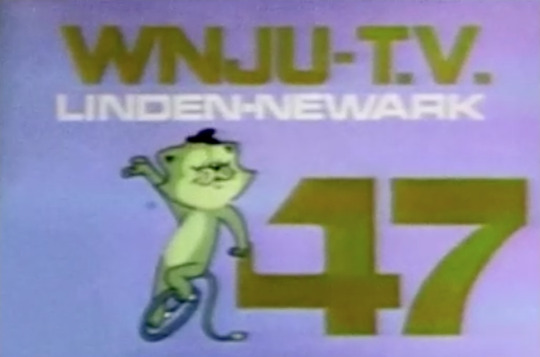
Channel 47 - Newark
22 notes
·
View notes

